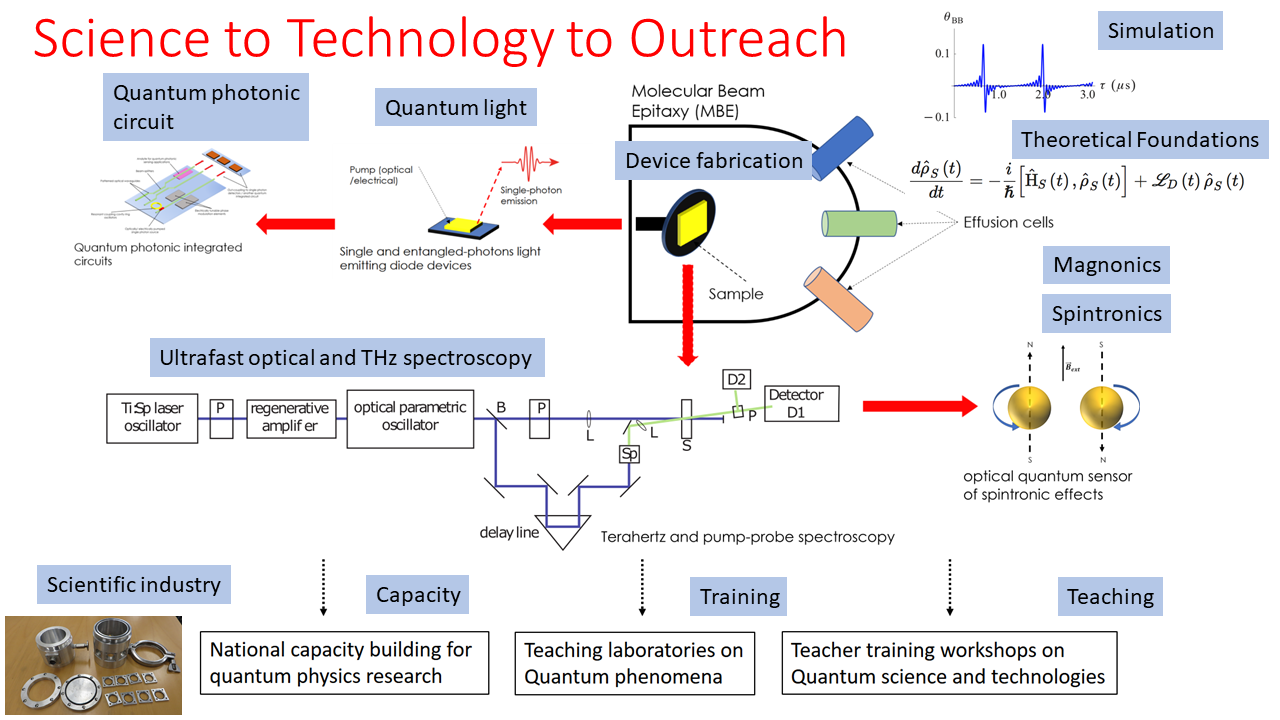The Quantum Revolution
Quantum Technologies and Riding the Wave of Quantum Revolutions

The second quantum revolution is poised to revolutionize the way we treat and view information, how information is processed, how we communicate, how data is transferred from point to point and also promises to radically change how we design drugs, solve exceptionally hard problems, make commerce secure, how we maintain our physical standards and just how we think about the world around us.
Quantum systems come in different kinds. An open quantum system is one which interacts with the environment or another quantum system. The study of open quantum systems gives us insight into fundamental questions of quantum cosmology, such as, ‘what took place in the early universe?’ and ‘what happens inside black holes?’ It also allows us to build devices with unprecedented performance and computing power called quantum computers in addition to promising secure communications systems. In order to make the quantum computer a reality, the Physics and Electrical Engineering Departments work in close synergy.
Please take a quick look at the summary of our vision for research in quantum systems.
Dr. Adam Zaman’s research focuses on answering questions about how realistic open quantum systems work and how we can use these systems to build a quantum computer that is useful and scaleable.
Dr. Moeez Hassan's quest is to explain gravity as a quantum force, which will help us understand the early universe and black holes. His work contributes to the global efforts to reconcile quantum mechanics and general relativity.
Quantum light is necessary for quantum computing and secure communication systems. Dr. Ata ul Haq and Dr. Ammar Khan’s lead the nano-quantum-photonics research group which is developing specialized light sources using nanoscale structures, which can generate quantum light. Dr. Nauman Zafar Butt’s research group is working on the hardware side by studying how to adapt the existing manufacturing processes of silicon chips, such as those used in everyday smart devices, specifically to encode qubits, which are the quantum equivalent of zeroes and ones of conventional computing.
Dr. Sabieh Anwar's research group creates single-photon sources in his laboratory and tries to understand how these quantum light signatures interact with magnets, spins and thin films created by atomic deposition. Materials which confound common perception, called quantum materials, can stoke a multitude of surprises, e.g. a solid that conducts on the surface but is an insulator in the bulk. Dr. Anwar explores how quantum light could be used to study the properties of these materials. Dr. Sabieh Anwar’s recent book published by the Institute of Physics UK also describes tabletop experiments meant to orient and train students and researchers on quantum mechanics, quantum optics and quantum information processing.
Baseline for Pakistan
The National Commission on Nanoscience and Nanotechnology (NCNST) was established in 2003 to spur mostly applied research in this area. This led to an increased awareness, state sponsorship and state-of-the-art facilities were established in the areas of electronics, agriculture, industry and health related scientific endeavors. Concomitantly, on the international stage there was also a frenzy in this area that led to considerable funding and immense opportunities for Pakistani scholars to receive training in this area in the world’s finest labs. Upon their homeward transition, these incoming researchers established research groups inside the country or were absorbed into existing groups and consequently, materials science allied nanotechnology research has become a major area of specialization. The discipline of nanomaterials also constitutes a major fraction of our national output in terms of scientific productivity. Under the NCNST recommended funding of approximately Rs. 967 million [R.S. Bajwa and K. Yaldram, J. Nanopart. Res. (2012) 14:721], with the exception of one Centre tasked with the fabrication of laser diodes, all centres were mandated to conduct applied research from a purely materials perspective, engineering new classes of materials with varying properties. What is amiss in most of this work is a deeper connection with quantum-inspired technologies.

Impact (a) Bridging the quantum gap Effects based on quantum coherence provide a paradigm shift in how we view nanotechnology and could provide the next natural step in the organic evolution of this area of scientific endeavour in the country. The transition from material to device is also much needed. This change in objectives can only be ushered by a foray into fundamental physics, powered by a strong theoretical understanding, assisted by world-class laboratory facilities combined with a penchant for homegrown equipment building, and with deliverables that focus on internationally recognizable research.
Research in quantum materials, processes, and quantum effects in devices is qualitatively different from nanomaterials research which has become the mainstay of our national enterprise, wherein the latter focuses more on materials properties and correlation of properties with structure instead of fundamentally novel ways of looking at truly quantum phenomena (such as quantum tunneling, valleytronics, quantum decoherence, quantum control, entanglement generation and its preservation, topological effects in low-dimensional systems etc). With the Laboratory for Quantum Technologies, we envisage to plug this ‘quantum energy gap’ in nanomaterials research. We believe that this laboratory can become a harbinger for quantum-related technologies.
(b) Capacity building in relatively unexplored areas in Pakistan Relatively new areas that will be introduced in the national scientific landscape through our ongoing work including (a) ultrafast characterization techniques in the visible, telecom and terahertz wavelength regimes; (b) synthesis of efficient quantum light sources and their integration into single photon circuits; (c) understanding of fundamental limits and optimization of quantum sensing, metrology and thermodynamic devices; (d) experimental opto-spintronics; and (e) manufacturing the tools for scientific discovery. Our investigations in quantum sensing also harbor implications for Pakistan Bureau of Standards that must conform to a complete revision of the SI unit system if it aims to meet international standards for commerce and trade.
With Pakistan being a formal Member of the Synchrotron-Light for Experimental Science in the Middle East (SESAME), we believe that research on this theme can become the catalyst for human resource training in the usage of bright light sources. With our proposed facilities of MBE, ultra-fast pump-probe spectroscopy, optical investigations of spin phenomena on the femtosecond time scale, ability to engineer quantum light sources and fundamental investigations of quantum phenomena on the nanoscale, we hope to build a strong national capacity in being able to exploit the immense opportunities offered by access to the SESAME.
Scientific deliverables In order to attain the envisaged impact, we have streamlined precise goals and associated deliverables which include the following:
- fundamental scientific research (quantum sensing and thermodynamics, opto-spintronics, optical properties and signatures of spintronic materials, magnonics, quantum light sources and their integration into photonic circuits),
- building of devices (single photon light sources, THz light source),
- building of instruments (scanning tunneling microscope, atomic force microscope and assembling a laser-MBE),
- demonstrations of quantum control and sensing (such as in spintronic devices and NV centres),
- theoretical work (quantum sensing and quantum dynamics) and finally,
- education and training (single photon quantum information processing bootcamps, refresher courses on quantum sciences).
Investigators
Dr. Adam Zaman (Department of Physics)
Dr. Ata ul Haq (Department of Physics)
Dr. Ammar Ahmad Khan (Department of Physics)
Dr. Syed Moeez Hassan (Department of Physics)
Dr. Nauman Zafar Butt (Department of Electrical Engineering)
Dr. Muhammad Sabieh Anwar (Department of Physics)
Research Groups
- Quantum Control
- Computational Physics
- Laboratory for Quantum Technologies

